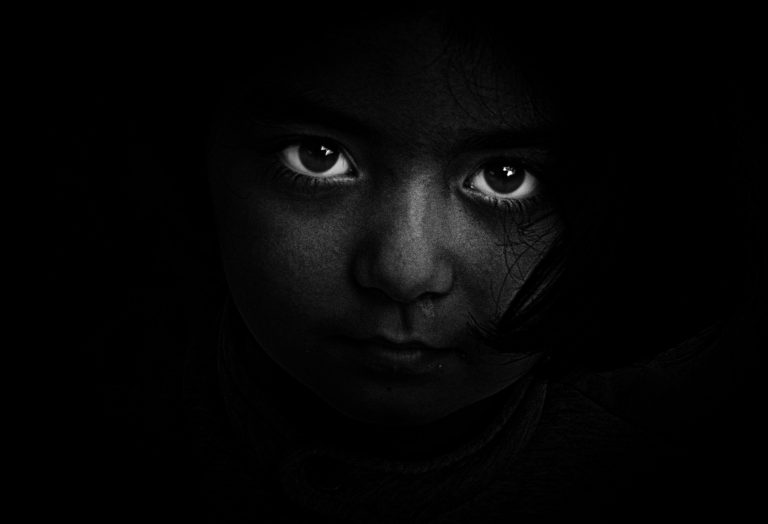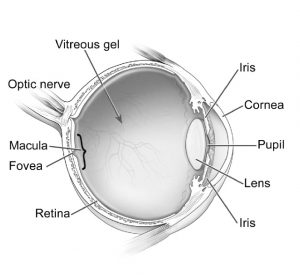
Is blindness an evolutionary regression? [Photo by omar alnahi from Pexels]
Table of Contents
The recent Netflix’s hit flick, Bird Box, surely startled the viewers with the thrilling scenarios revolving around the precept that once seen, expect an abrupt ferocious death. Given that, Malorie (the protagonist portrayed by Sandra Bullock) blindfolded herself and the two children, and embarked down the perilous river to seek a safer refuge. (N.B. If you have not seen it yet, you probably need to pause to dodge the spoilers ahead.) Ultimately, they reached the haven, which was revealed to be an old school for the blind. The surviving community was a population of primarily blind, and as such, immune, people. By and large, this film emanated a message to me that blindness should not be taken as an utter handicap but a trait that tenders a likely evolutionary edge.
Blindness defined
Blindness is a complete, or a nearly complete, lack of vision. Basically, two major forms exist. A partial blindness means a very limited vision. In contrast, a complete blindness means a total lack of vision — not seeing anything, even light.1
Causes of blindness
Some of the common causes of blindness include eye accidents or injuries, diabetes, glaucoma, macular degeneration, blocked blood vessels, retrolental fibroplasia, lazy eye, optic neuritis, stroke, retinitis pigmentosa, optic glioma, and retinoblastoma.1
Congenital blindness refers to a condition wherein a person has been blind since birth. In fact, several instances of infant blindness are due to inherited eye diseases, such as cataracts, glaucoma, and certain eye malformations. In this case, genetic factors play a role. Retinitis pigmentosa, for example, is a hereditary condition. The retinal cells slowly disintegrate and ultimately leads to an incurable blindness later in life. Albinism also leads to vision loss in which, at times, reaches the category of “legally blind“.
The mapping of the human genome led to the identification of certain genetic causes of blindness. Scientists recently identified hundreds of new genes associated with blindness and other vision disorders. Bret Moore and colleagues found 261 new genes linked to eye diseases.2 Furthermore, they said that these newly-identified genes from mouse models likely have an analogous counterpart gene in humans. Thus, their findings could shed light in identifying the genes causing blindness in humans.
Eye evolution
Humans evolved eyes that enabled sight or vision. About 500 million years ago, the earliest predecessors had eyes that could detect light from the dark. This early eye, called an “eyespot“, could sense ambient brightness (but not shapes), which sufficiently helped orient single-celled organism (e.g. Euglena) to circadian rhythm and photoperiodism, and of course to food.3
Soon, the eyespot evolved into a rather complex light-detecting structure, such as that found in flatworms. Their eyes could detect light direction. Also, their eyes enabled them to seek a better spot to hide from predators. As light was able to penetrate the deep seas, organisms such as Nautilus evolved pinhole eye. A small opening on it allowed only a thin pin of light to enter. This dramatically improved resolution and directional sensing.3
The pinhole eye evolved lens that regulated the degree of convergence or divergence of the transmitted rays. Furthermore, the lens helped distinguish spatial distance between the organism and the objects in its environment.3
A modern human eye has become more intricate by the presence of other eye structures. For instance, a transparent layer called cornea covered the opening (pupil) of the eye. This caused the inside of the eye to contain transparent body fluid called vitreous humor. The iris is the colored part near the pupil. The light-sensitive membrane, retina, contains the photoreceptor cells, i.e. the rods and the cones. Apparently, the evolution of the human eye concurred with the evolution of the visual cortex of the human brain.3

[Image credit: National Eye Institute, National Institutes of Health.]
Blindness – an evolutionary regression or a gain?
Should blindness be considered an evolutionary regression or an evolutionary gain? Blind beetle species that live in light-less caves, in the underground aquifers of Western Australia and the eyeless Mexican cave fish are some of the animals that once had a sight but lost it over millions of years.
Simon Tierney from the University of Adelaide offered an explanation to this seemingly evolutionary regression.4 Accordingly, the loss of sight in the cave fish species apparently led to the evolution of increased number of taste buds. In particular, pleiotropy might explain this manifestation. A pleiotropic gene, in particular, controls multiple (and possibly unrelated) phenotypic traits. In this case, the gene responsible for the eye loss might have also caused the increased number of taste buds. The eyesight may not be imperative in a light-deprived habitat; however, an amplified number of taste buds for an improved sense of taste is. Douglas Futuyma of the State University of New York at Stony Brook explained: 4
“So the argument is these mutations are actually advantageous to the organism because the trade off for getting rid of the eye is enhancing the fish’s tastebuds. It really looks like these evolutionary regressions are not a violation of Darwin’s idea at all. It’s just a more subtle expression of Darwin’s idea of natural selection.”
Heightened senses
In 2017, a research team posited that blind people do have enhanced abilities in their other senses. To prove this, they brain scanned blind participants in a magnetic resonance imaging (MRI) scanner. Accordingly, the scans revealed heightened senses of hearing, smell, and touch among blind participants as opposed to the participants who were not blind. Moreover, they found that blind people had enhanced memory and language abilities. Lotfi Merabet of the Laboratory for Visual Neuroplasticity at Schepens Eye Research Institute of Massachusetts Eye and Ear said:5
“Even in the case of being profoundly blind, the brain rewires itself in a manner to use the information at its disposal so that it can interact with the environment in a more effective manner.”
Conclusion
As the popular maxim goes, the eyes are the windows to the soul. In the presence of light, our eyes can perceive all the seemingly playful colors and spatiality that surround us. At times, a simple stare is all it takes to convey what we could have said in words. Despite the loss of sight in some of our co-specifics, their brain configured into an avant-garde stratagem that enabled them to do most of what a seeing person could. Based on what the researchers observed, they had enhanced interconnections in their brain that seemed to compensate for their lack of sight. Hence, blindness appears not as an evolutionary regression but probably a shift of path forward the evolutionary line.
— written by Maria Victoria Gonzaga
References
1 Blindness and vision loss: MedlinePlus Medical Encyclopedia. (2019, January 1). Retrieved from Medlineplus.gov
2 University of California – Davis. (2018, December 21). 300 blind mice uncover genetic causes of eye disease. ScienceDaily. Retrieved from www.sciencedaily.com/releases/2018/12/181221142516.htm
3 TED-Ed. (2015, January 8). YouTube. YouTube. Retrieved from https://www.youtube.com/watch?v=qrKZBh8BL-U
4 How does evolution explain animals losing vision? (2015, March 18). Abc.Net.Au. Retrieved from https://doi.org/http://abc.net.au/science/articles/2015/03/18/4192819.htm
5 Miller, S. G. (2017, March 22). Why Other Senses May Be Heightened in Blind People. Retrieved from https://www.livescience.com/58373-blindness-heightened-senses.html

